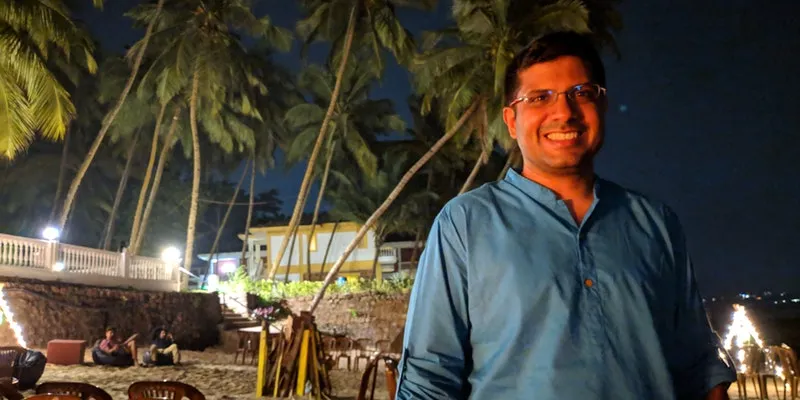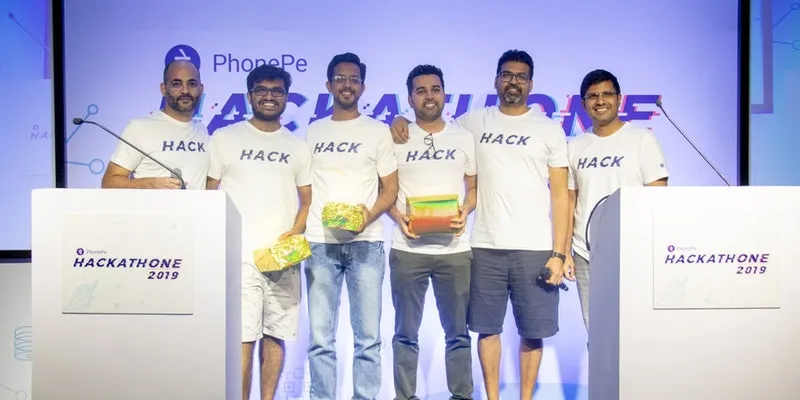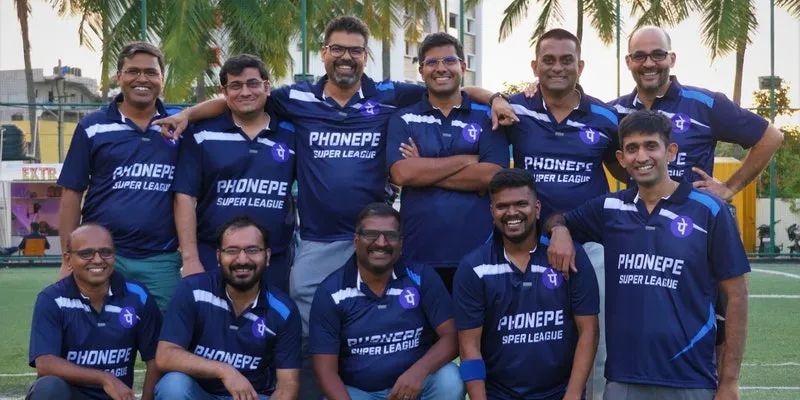[Techie Tuesday] PhonePe CTO Rahul Chari opted out of IIT to follow his heart and build a world-class product
In this week’s Techie Tuesday, we tell you the story of Rahul Chari, the man who built the stack for eKart logistics at Flipkart before he went on to build PhonePe, India’s first non-banking payment platform.
“Hustle is overrated when it comes to technology. Don’t try taking the shortest path; think at least two years ahead and anchor yourself to something that you can build continuously,” says Rahul Chari, Co-founder and CTO of PhonePe.
Unlike many other founders who think of IIT as the only stepping stone to success, Rahul believed differently. He cracked the premier exam and got admission to IIT-Bombay in 1995, but decided to bypass the institute. Instead, he joined the University of Mumbai to do what he always wanted to do: computer science engineering.
Today, the three-time entrepreneur has over 18 years of experience in storage visualisation, content management, and supply chain technology.
A typical startup hustle culture encourages one to build something as early as they can, iterate and fine-tune it, run towards hitting hockey-stick growth and then figure out how to rebuild the product for scale.
Rahul, however, believes otherwise.
Born from the Flipkart stable and with access to capital, PhonePe had the luxury to build its systems right. With that possibility, Rahul says he did not want to rush into building the platform.
“If you have the luxury to build it out right, win it, and make it a success, there is no point trying to be scrappy about your core systems. Even if it takes time, it is the right thing to do. The goal should be to keep your platform ahead of the curve. If you are behind the curve, you will always play catch up and increase tech-debt,” Rahul says.

Rahul Chari, Founder and CTO of PhonPe
The formative years
Hyderabad-born Rahul, now 42 years old, isn’t really comfortable talking about himself or making polite conversation.
Perhaps it’s because of the time he spent on his own in Muscat. Born to an architect and civil-engineer-father, Rahul lived in the Gulf between the age of four and nine years. He became habituated to finishing his homework quickly, at school, and coming home to spend the rest of his day in front of the television.
Time-traveling back to 35 years ago, Rahul says he often discusses with his wife how he only has vague memories of school, mostly because he is not in touch with many of his school friends. He also chose to stay away from Facebook.
A bookworm by choice
Rahul says that he has always been a rank-holder, at school and college.
“Whenever asked, my father would tell people that I scored 99 percent in school and people would doubt him. In reality, he never knew in which grade I was at that point of time,” he laughs. “I was doing well academically and in extra-curricular activities, so there was no need to dig in and fix anything,” he says.
Always inclined towards mathematics and physics, Rahul’s first experience with computers is etched vividly in his memory. He was in Class 8 when a friend of his father’s started a computer education centre. That led to a love for PC games.
”Gaming was a big influence for me to actually start getting curious about computers. I was very interested in Aladdin and Mario Brothers, and curious to understand how they were built,” he says.
He got his hands on an Atari game station and joined a centre to learn BASIC programming language. He was soon building stick computer games.
For his plus two, Rahul made it to Ruparel College, where most rank holders of Mumbai attended school. He initially opted for biology, since Computer Science required higher percentage, but then did all he could to shift to the Electrical and Computer Science Department. That was also when he was exposed to programming and compilers for the first time.
Choice out of exclusion
After his board exams, Rahul appeared for his JEE exams. With increasing interest in gaming, he decided to sidestep the IIT civil engineering course despite being among the chosen ones.
Rahul’s was the first batch of computer engineering at Sardar Patel College of Engineering (SPC), under Mumbai University. “Even after joining the course, a professor pressured me to join IIT,” Rahul says.
Frustrated at having to answer so many questions regarding his choice, Rahul ended up writing a column in his college magazine on‘Why you should not join IIT if you don’t get the course of your desire.’ He still keeps the issue handy, just in case.
In 1995, he got his first personal computer and actively started coding and learning by himself. He would experiment with different algorithms and constantly work on optimising them and running them faster, using minimum lines of code.
Rahul met Sameer Nigam, his Co-founder at PhonePe, during college. “We were political rivals for the first year and good friends for the rest of the three years,” he says.

Rahul at an office offsite
Heading to the US
The mentality back then was that a typical computer engineer from India would move to the US for a master’s course, get the H1B, and start working in the Valley.
“With cousins already working in the States as computer engineers, it was almost a set path for me,” Rahul says. That, combined with his curiosity to learn more, made Rahul reject an offer from Tata Consultancy Services and join Purdue University.
The master’s course was tough for the gold medalist from Mumbai University. Rahul realised the gap that existed between the amount of exposure an IIT-ian and a graduate from another college received.
When asked if he regretted his decision of not going to IIT, Rahul says:
“I strongly believe in the butterfly effect - if I had gone to IIT to study civil engineering, I wouldn’t be talking to you right now. I don’t ever think back. My attitude has always been that if there is an issue, I will go ahead and solve it.”
Up against the best-of-the-best engineers, Rahul had to work twice as hard to catch up. Working on individual projects, he was exposed to build features of an operating system, including the networking stack and scheduler. He also went on to build his own UDP-based chat system on top of a UNIX OS.
While still at Purdue, Rahul applied for an internship at Sun Microsystem’s research wing, Sun Labs. He worked on building transactional JVM to drive transactions with critical sections, with an automatic rollback to the initial state.
“It was a huge learning as some of the smartest people in the Bay Area were working at Sun Labs then,” he says. Rahul also got to interact with James Gosling, the father of Java, at Sun Labs. “I never gravitated to the dark side do an MBA,” he adds.
Choosing the path less travelled
After graduation, Rahul was spoilt for choice - he could continue his PhD with Prof Sunil Pravakar, Head of Computer Science division at Purdue, or go back to Sun Labs. Instead, he decided to do something completely new; he joined a startup, Andiamo Systems, which worked in the data storage space. It was an explicit choice - between research and product engineering, he was always more inclined towards the latter.
“Research required a different bent of life. But when you actually build something, have the product up and running, and have someone use that code - that satisfaction is different than the one you get from continuing to perfect something you are building,” Rahul says.
Douglas Comer, industry veteran and a professor at Purdue, influenced Rahul to join the industry.
“The philosophy of being very complete and clear about what you do, before thinking of doing too much - and ensuring that you create value from what you are doing - had a very strong influence on my choice,” he says.
Entering the startup ecosystem
Andiamo Systems was a Cisco-incubated startup, and Rahul worked on storage virtualisation, in a small team.
“Today, I consider myself an engineer, a product manager, and somebody who understands product marketing and customers, because of my stint at Andiamo,” he says.
While managing clients, including UBS and State Farm, Rahul recalls being the “ratlab”, spending nights coding tens of thousands of lines, while surviving on pizzas.
Andiamo Systems was later acquired by Cisco, and Rahul moved back to India in 2008, after four years with Cisco.
“To give up the love for a pay cheque is not easy; it was definitely not easier in the US. My parents were here and I was looking to pursue something on my own, which is why I moved back to India,” he says.
Rahul spent another year in Cisco to have a “softer landing”, taking up responsibilities of both a tech-lead and a manager.
First-time entrepreneur
Buying a house and settling down in Bengaluru came with its own set of challenges. That’s when he decided to start up in the real estate space, with something similar to what Housing.com did later.
Inspired by American real estate company Zillow, which allowed real estate listings on a map, Rahul decided to start Bhoomi.com. Given that there was no public domain information available in India, he was thinking on the lines of crowd-sourcing and anonymising data to normalise real estate prices. His idea made it to the first two rounds of Economic Times’ entrepreneurship programme, Power of Ideas.
After building the prototype for Bhoomi.com, Rahul approached a couple of friends to join hands. He met Sameer again and pitched his idea.
Sameer was, at that time, doing his MBA at Wharton School, and had received $25,000 as a grant to pursue a project idea as a company. He was thinking about something in online music, and convinced Rahul to drop the real estate idea and sell music instead - since it had significantly higher impact.
In early 2009, Rahul quit Cisco and built Manoramic.com, along with Sameer and Burzin Engineer, a common friend and also a co-founder of PhonePe. Manoramic was like the iTunes of India, an ad-free property where one could download tracks. They set up their office in SPE’s e-cell and on-boarded a few students from the college.
Manoramic aggregated content from SaReGaMa, Universal Music, Sony, and Simca. Rahul built a catalogue and a search service on top of it and the website. They also built an SDK for Symbian phones.
“We built the B2C property and had spent a lot of money acquiring rights for the content. But revenues were not as much,” Rahul says.

Rahul and Sameer at the PhonePe Hackathone, 2019
Going big with Google Labs
At that time, Google Labs India was launching a music streaming service and had approached SaReGaMa for content. “By then, we were already discussing powering SaReGaMa’s website,” Rahul recalls.
Initially, Google refused to come to Manoramic for it was still a small company. The internet giant wasn’t sure if Manoramic would be able to meet its SLAs, but tested Manoramic for through-put and scalability.
“They hit us from multiple IP addresses to see how much content and gig they could stream simultaneously to be able to power their property and we stood up to that test,” Rahul says.
Manoramic soon started powering Google music in Google Labs, in India, in 2010, pivoting to its B2B model. “The stack we built was similar to micro-services. The content and catalogue were built in such a way that the site was API-powered. We were able to re-purpose the backend and build on API layer to power any website,” Rahul says.
Soon, Manoramic was powering its existing aggregators, along with Google Music India and Gaana.com (except for the T-Series’ content). The team then decided to democratise music powering; that’s when MIME (Manoramic International Media Exchange) 360 came into being, in 2010.
Enter Flipkart
When Flipkart decided to launch music, they approached MIME 360, and acqui-hired it in October, 2011. “We were back to being B2C again,” Rahul says. Flipkart’s music download store, FLYTE, was powered by MIME 360.
Rahul started his Flipkart journey as Director of Engineering, spending a significant amount of time doing low-level design and architecture. Later, he built the supply chain, which is called the eKart today. Rahul “owes it to Flipkart” for understanding customer psychology, being customer-first, and eyeing “audacious goals” and not being “daunted by the tech to build it”.
“The Flipkart journey was like a roller-coaster! I went from being completely virtual and digital to going completely physical. The number of systems we built in Flipkart, including the promise and fulfillment engine, was extremely satisfying” Rahul exclaims.
On the supply chain side, Rahul got a huge reality check.
“Tech is great and solves a lot of problems. But when it comes to the heart of ecommerce - it is ultimately the supply chain and logistics. There was a clear role of where tech leads and where tech enables. Understanding that was a game changer,” Rahul says.
FLYTE was shut down in 2013. “A lot of conversation around the shutting down of FLYTE was around piracy and willingness of people to pay for content. However, one of the major reasons for it shutting down was that payments and micro-transactions were not solved for,” Rahul says.
In 2014, the Big Billion Days sale was introduced and Rahul recalls the nightmare that it was. “Some of the payment gateways came down in the first 10 minutes of the sale,” he says.
While cash-on-delivery was a great innovation by Flipkart, it was also a pain point. Money management, at scale, became a problem and the ecommerce player saw everything - from counterfeit notes to money getting lost and stolen, and accounting problems while depositing cash.
Betting on UPI
“Digital commerce was great, but it would not take off in the country at scale unless the problem of payments at scale was solved,” Rahul says. This problem statement excited both Rahul and Sameer.
Rahul quit Flipkart in October 2015, went big on UPI, and started PhonePe that December.

Team at PhonePe
“I and the Indian startup ecosystem owe Flipkart for the culture of being able to say that we can build real cool stuff at scale, in the tech space, to take on the giants,” Rahul says.
While Flipkart was instrumental in the ideation of PhonePe, the team was very sure that it would build it right and with a long-term view. Thus, it took nine months to actually launch the company.
“Today we manage 20 million transactions a day and we have not re-architected our system at all. It is a three-year-old product running on a Gen One platform,” Rahul says.
PhonePe was launched in tandem with UPI. It was the first non-banking app in UPI, revolutionising the digital payment segment.
Back to square one
Interestingly, Flipkart acquired PhonePe even before it was launched.
Flipkart was trying to solve the payments space. It launched PayZippy and invested in NGpay, so technically PhonePe was Flipkart’s third attempt at having a payments arm.
“When Binny (Bansal) took over as CEO (of Flipkart) in 2016, we started a conversation and Flipkart decided to invest in PhonePe,” Rahul says.
One thing led to the other, and PhonePe decided to merge back into the Flipkart group, as long as it could continue to build itself out as an independent platform.
And the rest, as they say, is history.
Looking back at his journey so far, Rahul says his parents letting him be and trusting his decisions have been instrumental to what he achieved over the years.
“My parents gave me a lot of exposure; I had all the luxuries. When I moved to the States, except for the roadways, which were extremely good, I didn't necessarily find a ‘wow’ moment as such, unlike others who move from smaller towns and find the US a dream destination. I never had that feeling - maybe that’s why it was easy for me to make the move back, despite having a green card,” Rahul says.
(Edited by Teja Lele Desai)


![[Techie Tuesday] PhonePe CTO Rahul Chari opted out of IIT to follow his heart and build a world-class product](https://images.yourstory.com/cs/2/3fb20ae02dc911e9af58c17e6cc3d915/RahulCharitechietuesday800x4001576480080084png?mode=crop&crop=faces&ar=2%3A1&format=auto&w=1920&q=75)


![[Watch] CEO Sameer Nigam on PhonePe's plans to dive deeper into India, way forward with Walmart](https://images.yourstory.com/cs/2/a182c7e0140711e987e2f7248b252f46/Imagepztt1575226594739jpg?fm=png&auto=format&h=100&w=100&crop=entropy&fit=crop)
![[Techie Tuesday] A reluctant engineer who went on to build tech products before their time - the story of Ramki Gaddipati of Zeta](https://images.yourstory.com/cs/2/3fb20ae0-2dc9-11e9-af58-c17e6cc3d915/Techie-tuesday-Ramki-Gaddipati-800x4001565613417336.png?fm=png&auto=format&h=100&w=100&crop=entropy&fit=crop)
![[Techie Tuesday] How a small-town boy went on to help Nandan Nilekani build IndiaStack](https://images.yourstory.com/cs/2/730b50702d6c11e9aa979329348d4c3e/techietuesday800x4001575886432210png?fm=png&auto=format&h=100&w=100&crop=entropy&fit=crop)




